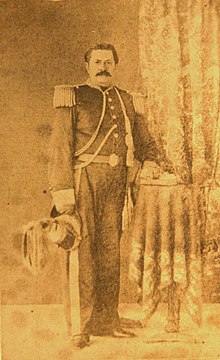
Francisco Solano López Carrillo was a Paraguayan military officer, politician and statesman who served as President of Paraguay between 1862 and 1870, of which he served mostly during the Paraguayan War (1864–1870). He succeeded his father Carlos Antonio López as the second president of Paraguay. Solano López is the only Paraguayan ruler to have been killed in action. He is one of only two Paraguayans to have received the rank of Marshal, along with José Félix Estigarribia.

The Paraguayan War, also known as the War of the Triple Alliance, was a South American war that lasted from 1864 to 1870. It was fought between Paraguay and the Triple Alliance of Argentina, the Empire of Brazil, and Uruguay. It was the deadliest and bloodiest inter-state war in Latin American history. Paraguay sustained large casualties, but the approximate numbers are disputed. Paraguay was forced to cede disputed territory to Argentina and Brazil. The war began in late 1864, as a result of a conflict between Paraguay and Brazil caused by the Uruguayan War. Argentina and Uruguay entered the war against Paraguay in 1865, and it then became known as the "War of the Triple Alliance."

The Battle of Riachuelo was a large and decisive naval battle of the Paraguayan War between Paraguay and the Empire of Brazil. By late 1864, Paraguay had scored a series of victories in the war, but on 11 June 1865, its naval defeat by the Brazilians on the Paraná River began to turn the tide in favor of the allies.

The Mato Grosso campaign was an early Paraguayan offensive in the Paraguayan War. Paraguay invaded the Brazilian province of Mato Grosso.

The military history of Brazil comprises centuries of armed actions in the territory encompassing modern Brazil, and the role of the Brazilian Armed Forces in conflicts and peacekeeping worldwide. For several hundreds of years, the area was the site of intertribal wars of indigenous peoples. Beginning in the 16th century, the arrival of Portuguese explorers led to conflicts with the indigenous peoples; a notable example being the revolt of the Tamoio Confederation. Sporadic revolts of African slaves also marked the colonial period, with a notable rebellion led by Zumbi dos Palmares. Conflicts were fought with other European nations as well – two notable examples being the France Antarctique affair, and a conflict with the Netherlands in the early 17th century over control of much of Northeastern Brazil. Although Portugal retained its possessions during conflicts with other nations, it lost control of the colony after the Brazilian war of Independence, which led to the establishment of the Empire of Brazil.

The Battle of Cerro Corá was the last battle of the Paraguayan War, fought on 1 March 1870, in the vicinity of Cerro Corá, 454 kilometres (280 mi) northeast of Paraguay's capital Asunción. It is known for being the battle in which Francisco Solano López, Paraguayan president, was killed at the hands of the Imperial Brazilian Army.
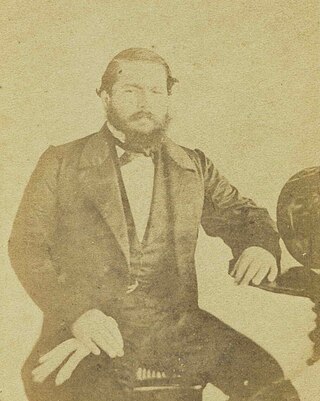
Venancio López Carrillo was a Paraguayan politician and military officer. He was Carlos Antonio López's son, and Francisco Solano López' brother; Carlos was Paraguay's leader between 1841 and 1862, and Francisco was President between 1862 and 1870. Venancio was for years Minister of War and Navy, and, before that, commander of the Asunción Paraguayan Army garrison.

The Battle of Pehuajó, also known as Battle of Corrales or Battle of Itati was fought during the Paraguayan War on 31 January 1866.
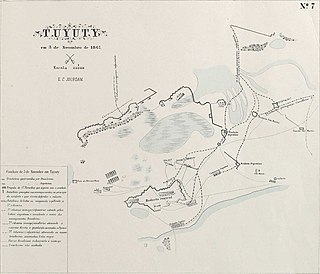
The Second Battle of Tuyutí was fought on 3 November 1867 between the Paraguayan Army and a smaller allied Brazilian-Argentine force. The Paraguayans lost twice as many soldiers as the allies and were defeated.

The capture of the steamer Marquês de Olinda was a Paraguayan naval action carried out on 12 November 1864, in Potrero-Poña, on the Paraguay River, which consisted of the capture of the Brazilian merchant ship and all on board. Paraguayan president Solano López ordered the imprisonment in response to the Brazilian invasion of Uruguay, before any formal declaration of war between Paraguay and the Empire of Brazil.

The Corumbá invasion, in the context of the Paraguayan War, was the first Paraguayan movement within the Brazilian territory, starting the Mato Grosso Campaign. On December 23, 1864, Solano López sent about five thousand men across the Paraguay River under the command of colonel Vicente Barrios. This column attacked the Novo de Coimbra fort on the 27th, which capitulated three days later; the Paraguayans then advanced towards Albuquerque, reaching Corumbá on January 4, 1865.

Francisco Isidoro Resquín Xara was a Paraguayan general during the War of the Triple Alliance. He was considered to be one of the most brilliant generals of the war and his writings are one of the main primary sources on the conflict.

José Elizardo Aquino Jara was a Paraguayan general who was considered a hero of the War of the Triple Alliance. He was one of the first senior Paraguayan military leaders to die in combat. Aquino was a lieutenant colonel at the time of being shot during the Battle of Boquerón.
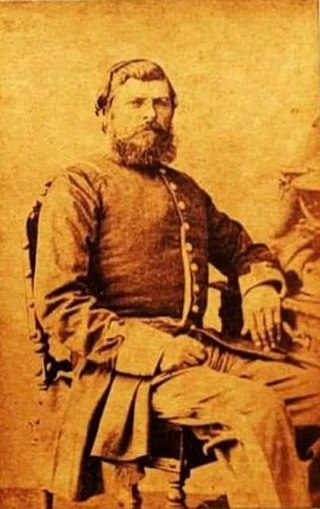
Antonio de la Cruz Estigarribia was a Paraguayan Lieutenant colonel who was notable for his service in the Paraguayan War. He served as one of the main Paraguayan commanders during the Invasion of Rio Grande do Sul, organizing the Battle of São Borja and the Siege of Uruguaiana before his surrender.

Pedro Ignacio Meza was a Paraguayan commodore who commanded the Paraguayan Navy in the early years of the War of the Triple Alliance until his death at the Battle of Riachuelo.
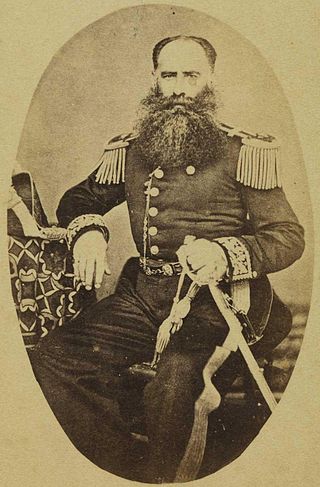
Vicente Barrios Bedoya was a Paraguayan general and politician who was the son-in-law of President Carlos Antonio López. Under López and his successor, Marshal and President Francisco Solano López, Barrios held many positions throughout the earlier years of the Paraguayan War and participated in the earlier battles and campaigns of the war.

The Corrientes campaign or the Paraguayan invasion of Corrientes was the second campaign of the Paraguayan War. Paraguayan forces occupied the Argentinian city of Corrientes and other towns in Corrientes Province. The campaign occurred at the same time as the Siege of Uruguaiana.
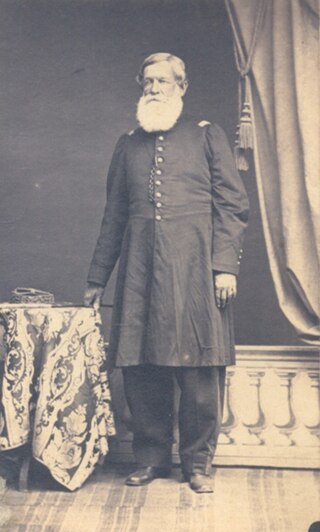
Wenceslao Paunero was an 19th-century Argentine General, politician and diplomat of Uruguayan origin. He was born within the Banda Oriental and would go on to be a major member of the Unitarian Party. He was also the Minister of War and Navy of Argentina and the provisional Governor of Córdoba.

The San Fernando massacre, was an episode that took place on 21 December 1868, on the eve of the Battle of Lomas Valentinas, during the Pikysyry Campaign in the Paraguayan War, which consisted of the summary trial and execution of hundreds of prisoners by order of Paraguayan president Francisco Solano López. Some prisoners were accused of plotting an alleged conspiracy to overthrow López. Among the dead was López's own brother, Benigno López.

José María Bruguez (1827-1868) was a Paraguayan general during the Paraguayan War. He was one of the most prominent Paraguayan generals of the war, being known for his artillery services during naval engagements of the war. He died during the 1868 San Fernando massacre after President Francisco Solano López accused Bruguez of conspiring against him.
